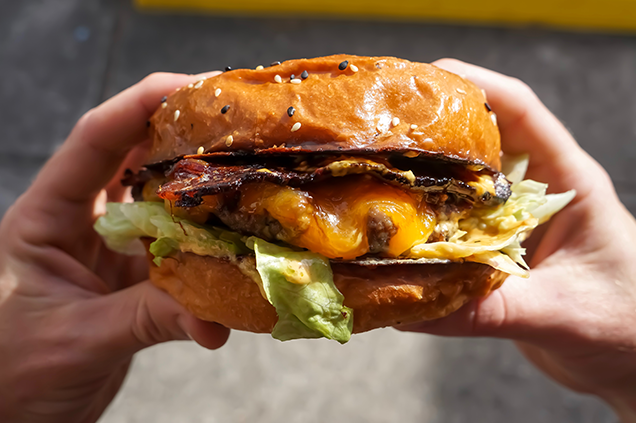By Dr Priscila Pereira Machado, Institute for Physical Activity and Nutrition (IPAN).
Summary
- Ultra-processed foods (UPFs) are dominating our diets - but what does that term actually mean? Deakin research is raising awareness on just that.
- Dr Machado's research will develop recommendations on how to best communicate about UPFs to consumers.
- This work has huge potential to help people understand the dangers associated with consuming UPFs and to generate strong support for policies targeting these foods.
In a world of 'day on a plate' TikTok reels and Insta nutritionists, one relatively new term is causing confusion among consumers - ultra-processed foods (UPFs). But while we've heard about the dangers of 'junk' foods for years, consumers' understanding of UPFs is limited.
With clever marketing and the lure of convenience, UPFs now dominate our diets. Contrary to popular belief, they extend beyond the realm of typical 'junk' food, infiltrating even seemingly healthy choices. When you reach for that energy-boosting granola bar or grab a bowl of your favourite morning cereal, you might be unknowingly consuming ultra-processed foods.
This is where my new research comes in. Supported by a Heart Foundation Vanguard grant, the study aims to raise awareness about UPFs in Australia and will develop recommendations on how to best communicate with consumers.
What makes a food ultra-processed?
Unprocessed or minimally processed foods are whole foods whose vitamins and nutrients are intact; the food is in, or close to, its natural state. Examples include bananas, cucumbers, fresh fish and raw unsalted nuts.
Processing changes a food from its natural state by adding salt, oil, sugar or other substances. Examples include tinned fish, canned vegetables, fruits in syrup, and breads. Most processed foods have two or three ingredients.
Ultra-processed foods have 'many' industrial ingredients, such as emulsifiers, sugars, salt, harmful fats, and artificial colours, flavours or preservatives.
Industrially manufactured, UPFs are ready‐to‐eat, affordable, heavily promoted and conveniently packaged products - think fast foods, soft drinks, some fruit juices, pre-packaged snacks and sweet breakfast cereals.
They're usually packed with calories, lacking in essential nutrients, and include contaminants and additives that promote insulin resistance, lead to weight gain and impact the natural balance of our gut. Despite often huge portion sizes, UPFs also commonly lack fibre - meaning we're hungry again sooner.
UPFs make up a BIG portion of our diet
My previous research suggests many Australians are unwittingly eating their way to chronic ill-health by choosing ultra-processed foods that are often wrongly marketed as healthy.
Our research shows that UPFs comprise a whopping 42 per cent of the Australian diet. And their consumption drives an excessive intake of salt, refined sugar, saturated and trans fats that increase the risk of heart disease - the leading cause of death in Australia.
Our team, based at Deakin University's Institute for Physical Activity and Nutrition (IPAN), also detected a direct association between UPF consumption and obesity, a major cardiovascular disease (CVD) risk factor, with high UPF consumers having a 61 per cent higher risk of obesity than low consumers. UPF consumption is higher among young people and lower socioeconomic groups, the latter known to be more susceptible to CVD.
As more convenient options hit our supermarket shelves, it's becoming harder for families to avoid UPFs. In the first comprehensive national audit of toddler foods and milk drinks in Australia, IPAN researchers found that about 80 per cent of packaged toddler foods were sweetened snack foods and 85 per cent were ultra-processed.
Research published in 2023 led by Deakin's Dr Melissa Lane for the first time established a link between diets high in ultra-processed foods and an increased risk of depression. The findings show the risk of depression jumps markedly among people whose daily diet comprises more than 30 per cent of ultra-processed food. In studying the diet habits of 23,000, Dr Lane and team revealed that Australians who ate the most ultra-processed food had about a 23 per cent higher risk of depression compared to those who ate the least amount. The subsequent umbrella review of the evidence has shown increased UPF consumption linked to more than 30 adverse health outcomes.

Health messages about 'junk foods' aren't hitting the mark
The current Australian dietary guidelines, developed by the National Health and Medical Research Council and used to educate Australians as early as primary school, do not address the specific harms of ultra-processed foods.
Our previous research also shows that UPFs are incorrectly presented by the Australian media. Frequently defined as 'junk foods', UPFs include many foods that consumers may not perceive as unhealthy, such as plant‐based milks, flavoured yoghurts, and ready‐to‐heat meals.
Research led by former IPAN PhD student Sarah Dickie found that three quarters of UPFs display a Health Star Rating of 2.5 stars or more - a concerning revelation given that 3 or 4-star ratings on UPFs do not reflect their true nutritional value and can easily mislead consumers.
So, while we might be better at understanding why a burger, chips and soft drink are harmful to our health, we might be misled to believe that our daily bowl of ultra-processed cereal is in fact good for us.
This is worth considering because misleading nutrition information is prevalent, particularly on social media and websites, as shown in research by IPAN PhD student Emily Denniss.
What were doing about it
There is widespread recognition that public policies must focus on reducing UPF consumption. The Australian Academy of Science's decadal plan for the science of nutrition cites increased nutrition literacy as a key strategy to reduce the burden of chronic disease.
There are also national and global calls to reduce UPF consumption to improve heart health, with the Public Health Association of Australia and Dietitians Australia advocating for inclusion of UPFs in the upcoming review of the Australian dietary guidelines.
My new project will provide a better understanding of how we can tailor messages about UPFs to consumers to inform dietary guidelines, the media and professional practice.
A survey of 1,000 adults is underway to assess their understanding and identification of UPFs. It will guide the co‐design of a new framework to help authorities develop targeted health messages based on best practices for length, content, structure, style, language and tone to resonate with different age and sociodemographic groups.
Drawing on the advice of specialist health communicators, UPF experts and the IPAN Consumer Network, the messages will be test reviewed to ensure they can effectively increase awareness about UPFs.
CVD causes one in four deaths in Australia and three-quarters of Australians are at risk of developing the disease, but with healthier lifestyle and dietary choices most risk factors are preventable. Our work has huge potential to help people understand the dangers associated with consuming UPFs and to generate strong support for policies targeting these foods.
About Dr Priscila Pereira Machado

Dr Priscila Pereira Machado is a Research Fellow at the Institute for Physical Activity and Nutrition (IPAN). Her research focuses on understanding the role of ultra-processed foods in the food system and human health, evaluation of sustainable healthy diets, and nutrition policy.
- Secured over 1.5m in fellowships and grants, including a Deakin University Postdoctoral Fellowship and as a Chief Investigator on a 2023 Heart Foundation Vanguard Grant.
- Awarded 2024 NHMRC Investigator Grant Emerging Leadership Fellowship to address the burden of chronic diseases attributable to ultra-processed foods in Australia to commence in 2025.
- Supervised one Masters and one PhD candidate to completion, and currently supervises three Masters, two PhDs and one postdoctoral fellow.
The text of this article is licensed under the Creative Commons Attribution (CC BY) 4.0






